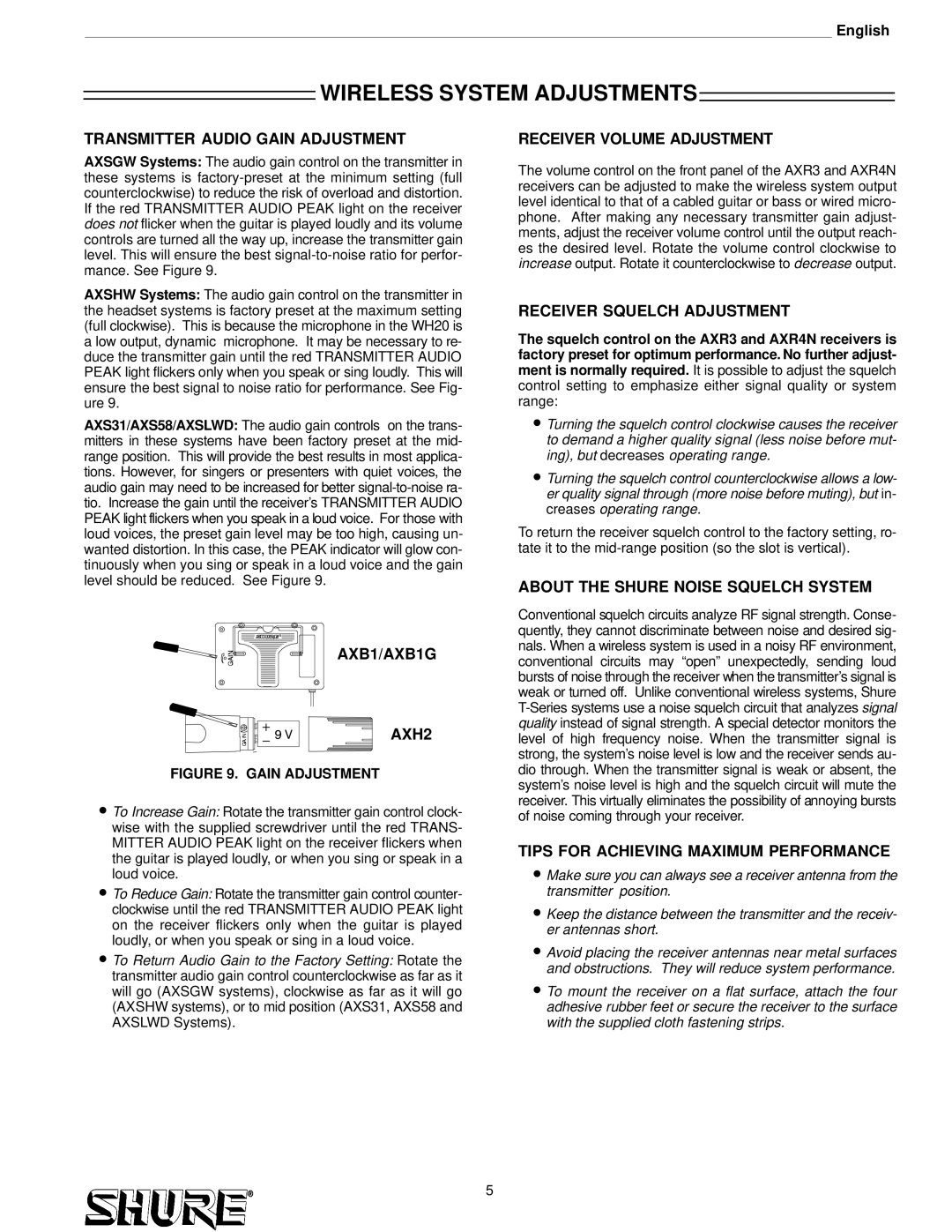
English
 WIRELESS SYSTEM ADJUSTMENTS
WIRELESS SYSTEM ADJUSTMENTS
TRANSMITTER AUDIO GAIN ADJUSTMENT
AXSGW Systems: The audio gain control on the transmitter in these systems is
AXSHW Systems: The audio gain control on the transmitter in the headset systems is factory preset at the maximum setting (full clockwise). This is because the microphone in the WH20 is a low output, dynamic microphone. It may be necessary to re- duce the transmitter gain until the red TRANSMITTER AUDIO PEAK light flickers only when you speak or sing loudly. This will ensure the best signal to noise ratio for performance. See Fig- ure 9.
AXS31/AXS58/AXSLWD: The audio gain controls on the trans- mitters in these systems have been factory preset at the mid- range position. This will provide the best results in most applica- tions. However, for singers or presenters with quiet voices, the audio gain may need to be increased for better
RECEIVER VOLUME ADJUSTMENT
The volume control on the front panel of the AXR3 and AXR4N receivers can be adjusted to make the wireless system output level identical to that of a cabled guitar or bass or wired micro- phone. After making any necessary transmitter gain adjust- ments, adjust the receiver volume control until the output reach- es the desired level. Rotate the volume control clockwise to increase output. Rotate it counterclockwise to decrease output.
RECEIVER SQUELCH ADJUSTMENT
The squelch control on the AXR3 and AXR4N receivers is factory preset for optimum performance. No further adjust- ment is normally required. It is possible to adjust the squelch control setting to emphasize either signal quality or system range:
•Turning the squelch control clockwise causes the receiver to demand a higher quality signal (less noise before mut- ing), but decreases operating range.
•Turning the squelch control counterclockwise allows a low- er quality signal through (more noise before muting), but in- creases operating range.
To return the receiver squelch control to the factory setting, ro- tate it to the
ABOUT THE SHURE NOISE SQUELCH SYSTEM
![]() +
+
![]() - 9 V
- 9 V
FIGURE 9. GAIN
AXB1/AXB1G
AXH2
Conventional squelch circuits analyze RF signal strength. Conse- quently, they cannot discriminate between noise and desired sig- nals. When a wireless system is used in a noisy RF environment, conventional circuits may ªopenº unexpectedly, sending loud bursts of noise through the receiver when the transmitter's signal is weak or turned off. Unlike conventional wireless systems, Shure
•To Increase Gain: Rotate the transmitter gain control clock- wise with the supplied screwdriver until the red TRANS- MITTER AUDIO PEAK light on the receiver flickers when the guitar is played loudly, or when you sing or speak in a loud voice.
•To Reduce Gain: Rotate the transmitter gain control counter- clockwise until the red TRANSMITTER AUDIO PEAK light on the receiver flickers only when the guitar is played loudly, or when you speak or sing in a loud voice.
•To Return Audio Gain to the Factory Setting: Rotate the transmitter audio gain control counterclockwise as far as it will go (AXSGW systems), clockwise as far as it will go (AXSHW systems), or to mid position (AXS31, AXS58 and AXSLWD Systems).
receiver. This virtually eliminates the possibility of annoying bursts of noise coming through your receiver.
TIPS FOR ACHIEVING MAXIMUM PERFORMANCE
•Make sure you can always see a receiver antenna from the transmitter position.
•Keep the distance between the transmitter and the receiv- er antennas short.
•Avoid placing the receiver antennas near metal surfaces and obstructions. They will reduce system performance.
•To mount the receiver on a flat surface, attach the four adhesive rubber feet or secure the receiver to the surface with the supplied cloth fastening strips.
5
